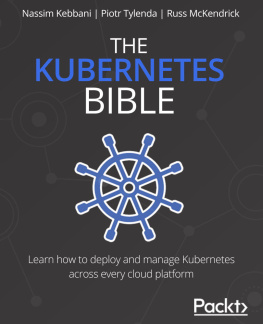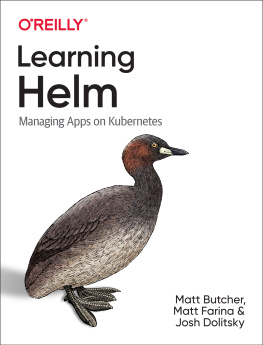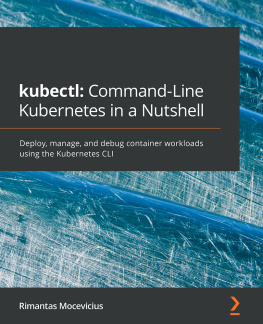Andrew Block - Managing Kubernetes Resources Using Helm: Simplifying how to build, package, and distribute applications for Kubernetes, 2nd Edition
Here you can read online Andrew Block - Managing Kubernetes Resources Using Helm: Simplifying how to build, package, and distribute applications for Kubernetes, 2nd Edition full text of the book (entire story) in english for free. Download pdf and epub, get meaning, cover and reviews about this ebook. year: 2022, publisher: Packt Publishing, genre: Computer. Description of the work, (preface) as well as reviews are available. Best literature library LitArk.com created for fans of good reading and offers a wide selection of genres:
Romance novel
Science fiction
Adventure
Detective
Science
History
Home and family
Prose
Art
Politics
Computer
Non-fiction
Religion
Business
Children
Humor
Choose a favorite category and find really read worthwhile books. Enjoy immersion in the world of imagination, feel the emotions of the characters or learn something new for yourself, make an fascinating discovery.
- Book:Managing Kubernetes Resources Using Helm: Simplifying how to build, package, and distribute applications for Kubernetes, 2nd Edition
- Author:
- Publisher:Packt Publishing
- Genre:
- Year:2022
- Rating:4 / 5
- Favourites:Add to favourites
- Your mark:
Managing Kubernetes Resources Using Helm: Simplifying how to build, package, and distribute applications for Kubernetes, 2nd Edition: summary, description and annotation
We offer to read an annotation, description, summary or preface (depends on what the author of the book "Managing Kubernetes Resources Using Helm: Simplifying how to build, package, and distribute applications for Kubernetes, 2nd Edition" wrote himself). If you haven't found the necessary information about the book — write in the comments, we will try to find it.
Reduce the complexity of managing applications on Kubernetes and develop an enterprise pattern for application delivery
Key Features- Learn best practices from the core maintainer of Helm for application delivery and life cycle management
- Manage applications deployed in Kubernetes effectively using Helm
- Go beyond the basics when using Helm with key security considerations and management options
Containerization is one of the best ways to implement DevOps, and learning how to execute it effectively is an essential part of a developers skillset. Kubernetes is the current industry standard for container orchestration. This book will help you discover the efficiency of managing applications running on Kubernetes with Helm.
Starting with a brief introduction to Helm and its impact on users working with containers and Kubernetes, youll delve into the primitives of Helm charts and their architecture and use cases. From there, youll understand how to write Helm charts in order to automate application deployment on Kubernetes and work your way toward more advanced strategies. These enterprise-ready patterns are focused on concepts beyond the basics so that you can use Helm optimally, looking at topics related to automation, application development, delivery, lifecycle management, and security.
By the end of this book, youll have learned how to leverage Helm to build, deploy, and manage applications on Kubernetes.
What you will learn- Understand how to deploy applications on Kubernetes with ease
- Package dynamic applications for deployment on Kubernetes
- Integrate Helm into an existing software release process
- Develop an enterprise automation strategy on Kubernetes using Helm
- Use Helm within a Helm Kubernetes operator
- Leverage Helm in a secure and stable manner that fits the enterprise
- Discover the ins and outs of automation with Helm
This book is for Kubernetes developers or administrators who are interested in learning Helm to provide automation for app development on Kubernetes. Although no prior knowledge of Helm is required, basic knowledge of Kubernetes application development will be useful.
Table of Contents- Understanding Kubernetes and Helm
- Preparing a Kubernetes and Helm Environment
- Installing Your First App with Helm
- Scaffolding a New Helm Chart
- Helm Dependency Management
- Understanding Helm Templates
- Helm Lifecycle Hooks
- Publishing to a Helm Chart Repository
- Testing Helm Charts
- Automating Helm with CD and GitOps
- Using Helm with the Operator Framework
- Helm Security Considerations
Andrew Block: author's other books
Who wrote Managing Kubernetes Resources Using Helm: Simplifying how to build, package, and distribute applications for Kubernetes, 2nd Edition? Find out the surname, the name of the author of the book and a list of all author's works by series.









